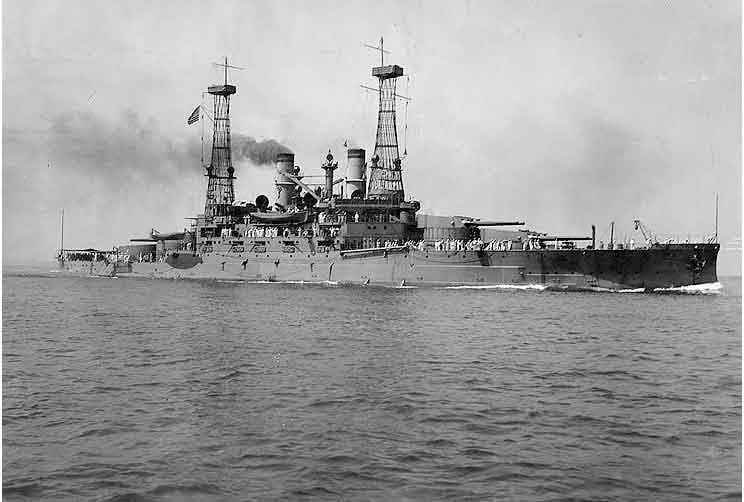USS South Carolina BB-26

South Carolina IV
(Battleship No. 26: displacement 16,000 (normal); length 452'9"; beam 80'2½" (waterline); draft 24'6½" (mean); speed 18.86 knots (trial); complement 751; armament 8 12-inch guns, 22 3-inch guns, 2 3-pounder guns, 2 21-inch torpedo tubes; class South Carolina)
The fourth South Carolina (Battleship No. 26) was laid down on 18 December 1906 at Philadelphia by William Cramp & Sons. It was launched on 1 July 1908, sponsored by Miss Frederica Ansel, and commissioned on 1 March 1910 with Captain Augustus F. Fechteler in command.
South Carolina departed Philadelphia on 6 March for a shakedown cruise, visiting the Danish West Indies and Cuba, then Charleston, S.C., from 10 to 15 April. After conducting trials off the Virginia Capes and Provincetown, Mass., the battleship visited New York City on 17 and 18 June for a reception for former President Theodore Roosevelt. Voyage repairs at Norfolk, naval militia training duty, and Atlantic Fleet maneuvers off Provincetown and the Virginia Capes occupied her until November. Between 1 November 1910 and 12 January 1911, she voyaged to Europe and back with the 2nd Battleship Division, visiting Cherbourg, France, and Portland, England. Upon returning to Norfolk, she underwent repairs, then conducted tactical training and maneuvers off the New England coast.
Following a short visit to New York, she sailed east with the 2nd Battleship Division to Copenhagen, Denmark, Stockholm, Sweden, and Kronstadt, Russia. During the return from Kronstadt, she reached Kiel, Germany, on 21 June in time for the Kiel Yachting Week, hosted by Kaiser Wilhelm II. On 13 July 1911, she arrived off Provincetown, Mass., for battle practice along the coast to the Chesapeake Bay.
Late in 1911, she participated in a naval review in New York and maneuvers with the 1st Squadron out of Newport, R.I. On 3 January 1912, she left New York for winter operations near Guantanamo Bay, Cuba, returning to Norfolk on 13 March. Until late June, she cruised the East Coast as far north as Newport. In June, she participated in welcome receptions at Hampton Roads and New York for the visiting German Squadron, comprised of the battle cruiser Moltke and two cruisers, Bremen and Stettin. On 30 June, she entered the Norfolk yard for an overhaul.
Just over three months later, she sailed to New York for a four-day visit, from 11 to 15 October. This was followed by a month of exercises off the coasts of New England and the Virginia Capes. From mid-November to mid-December, South Carolina steamed with the Special Service Division, visiting Pensacola, New Orleans, Galveston, and Vera Cruz, Mexico. She returned to Norfolk on 20 December, staying there until 6 January 1913, when she sailed to Colón, Panama, to observe the newly-completed Panama Canal. After maneuvers near Guantanamo Bay, she returned to Norfolk on 22 March and cruised north to Newport, stopping in New York from 28 to 31 May for the dedication of a memorial to the battleship Maine.
After training midshipmen in the Virginia Capes area, South Carolina embarked on a 16-month mission in the Gulf of Mexico and the Caribbean Sea. From late June to mid-September 1913, she patrolled the eastern coast of Mexico, protecting American interests in Tampico and Vera Cruz. After an overhaul in Norfolk from late September 1913 to early January 1914, she headed to Culebra Island for maneuvers.
On 28 January, the battleship landed marines at Port-au-Prince, Haiti, to guard the United States legation and establish a field radio station amid political turmoil. She left Port-au-Prince on 14 April after some stability was restored under General Orestes Zamor, the new Haitian President. After coaling at Key West, she sailed to Vera Cruz, sending a landing force ashore to join the city's occupation for a month. South Carolina spent the troubled summer of 1914 monitoring conditions in Santo Domingo and Haiti.
By her return to Norfolk on 24 September, World War I had been underway for two months. On 14 October, she entered the Philadelphia yard for revitalization, reemerging on 20 February 1915. She headed south for battle practice near Cuba, significant due to the diplomatic crisis following Germany's declaration of the waters around England as a war zone. Despite the sinking of Lusitania, the U.S. remained neutral, and South Carolina continued routine operations of exercises, summer operations, and periodic repairs until the U.S. joined the war in April 1917.
During the war, South Carolina primarily operated along the East Coast. On 9 September 1918, she escorted a convoy to France, returning to the U.S. after a brief period. After the Armistice on 11 November 1918, she resumed gunnery training service.
From mid-February to late July 1919, South Carolina made four round trips between the U.S. and Brest, France, transporting over 4,000 World War I veterans. After an overhaul at Norfolk Navy Yard, she embarked midshipmen at Annapolis for a Pacific cruise, departing on 5 June 1920. She transited the Panama Canal, visited Hawaii and the West Coast, and returned to Annapolis on 2 September via San Diego and the canal. She then sailed to Philadelphia, where she remained for seven months.
In April 1921, South Carolina cruised to Culebra Island in the West Indies for training, then operated in Chesapeake Bay. On 29 May, she embarked midshipmen at Annapolis for a summer training cruise, calling at Christiania, Norway, and Lisbon, Portugal, before heading to Guantanamo Bay. She debarked the midshipmen at Annapolis on 30 August and steamed to Philadelphia, arriving the next day. South Carolina was decommissioned at Philadelphia on 15 December 1921 and remained there until her name was struck from the Navy list on 10 November 1923. Her hulk was sold for scrap on 24 April 1924, in accordance with the Five-Power Naval Treaty of Washington.
 >
>